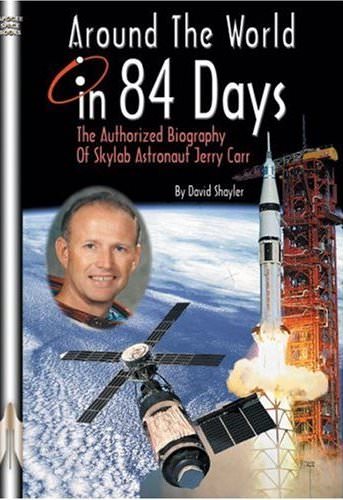Flying into space requires money, good fortune and desire. Some astronauts relied upon the government for money, had good fortune when luck was needed and felt the desire to push themselves ever onward. One such astronaut is Jerry Carr whose biography, “Around the World in 84 Days” by David Shayler demonstrates the validity of these requirements as well as the costs and benefits of becoming an astronaut.
Jerry Carr commanded the third and final crew of the Skylab mission. While doing this, he accumulated a number of records, including the longest time in space at 84 days. As well, he and his team effectively closed the book on the Apollo story, as the next manned flight by the United States was via the Space Shuttle. While this was a highlight of his life, it required lots of preparation. Hence this biography starts well before Carr’s application to NASA in 1965 and extends well past his final days at NASA in 1977. In so doing, this book shows a lot of the person that made up the astronaut, the husband, the father and the engineer.
Shayler’s book begins by setting the scene of Carr’s application and acceptance to be a NASA astronaut. The next chapter skips back to his early years as a boy scout, going through school and then trying to identify a future. The following chapters follow the unfolding of Carr’s life; as a pilot in the marine corps, as an Apollo astronaut candidate with NASA, as a trainee and then a participant for living on Skylab, as a technical expert after Skylab and last as a technical expert through to retirement. Aside from a life spent mostly in the field of aerospace, the flow of Carr’s life, its trials, tribulations and exultations appear as common place as any other middle income bread winner.
The distinctive feature of Carr’s life and the compelling aspect of Shayler’s book is, of course, Carr the astronaut. Here, it is mostly of his preparation for and occupation of Skylab. Living in an enclosed space the size of a three bedroom bungalow gave Carr and his two crew mates lots of opportunity for experimentation and research. Shayler, however, gives due deference to the general reader and stays away from technical descriptions. Rather, he considers more the human side; a spontaneous Christmas tree from can labels, a weekly shower, and adaptations due to weightlessness. Shayler’s choice to keep the vein of the book along the emotive rather than technical will give the reader a powerful appreciation of the human spirit enduring and flourishing in a completely foreign environment.
While Shayler keeps the biography principally upon Carr and his involvement with Skylab and NASA, he does branch out to other aspect of his life. The book shows Carr extending his awareness from military applications out to human factor design and on to art appreciation. He is seen to keep in contact with his six children, his step children and the appreciating number of grand children. While he did provide appreciable consulting work for the design of the Space Shuttle and the International Space Stations, this book shows that there was indeed life for Carr after being an astronaut, and the life was well flavoured.
To further embellish his book, Shayler has included a brief list of Carr’s records and awards, a brief narrative of other, related astronauts and a DVD with original videos from the Skylab mission. This portion, and some other sections, read dryly as if a direct transcription from a flight diary. In recognition of this, Shayler has kept them well balanced with emotive quotes from direct interviews. Thus, “Around the world in 84 Days – The Authorized Biography of Skylab Astronaut Jerry Carr” by David Shayler is a pleasant recap of an astronaut with a very accomplished life.
Click here to read more reviews or buy this book from Amazon.com.

